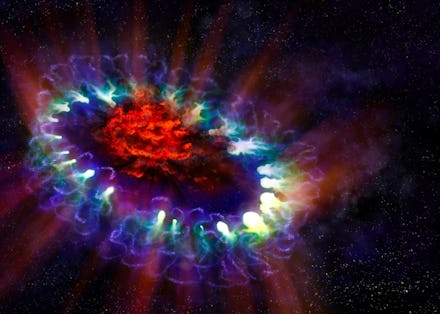Scientists mapped the inside of a stellar explosion and may have found proof for the circle of life

Space is a messy, violent place: When a very large star runs out of gas (literally), the star’s molten innards collapse, triggering a giant explosion known as a supernova that flings matter across space.
Like an explosion here on Earth, a supernova leaves behind dust and gas that make it hard to see what’s left at the center. But now, scientists have managed to peer inside a supernova’s aftermath, and two new papers with overlapping groups of authors share what they’ve found.
The scientists studied a supernova known as 1987A. It’s the closest explosion to Earth in centuries, just 166,000 light-years away in the neighboring Large Magellanic Cloud, so we can get an unusually good look at it. And because it’s a relatively recent explosion, its parts are less muddled together.
And they had a helpful tool on their side, the Atacama Large Millimeter/submillimeter Array, known as ALMA. It’s a set of 66 antennae spread across a plateau in the Chilean Andes to mimic one giant telescope. It sees millimeter waves, longer than the light our eyes see, which let it see through the gas, dust and other mess left after the explosion.
One of the new papers, published in the Astrophysical Journal Letters, creates a 3-D picture of the structure of what’s left at the center of supernova 1987A. That imaging shows a lumpy tangle of silicon monoxide in purple and carbon monoxide in yellow (yes, that’s the same thing your home hopefully has a detector for). The clumping doesn’t quite match what general models had predicted, although the astronomers conclude those models are definitely on the right track.
The other paper, published in Monthly Notices of the Royal Astronomical Society, identifies the specific molecules left behind in the supernova’s core. Many of those are compounds astronomers have spotted in the wake of this and other supernovae before, but they also spotted tiny amounts of two chemicals that have never before been connected to new supernovae.
Those two molecules are sulfur monoxide and a charged particle called formylium. The scientists want to keep using ALMA data to see if there may be other molecules that previous supernova studies have missed. They think the presence of these two new chemicals may mean we need to rethink our understanding of how a supernova actually works — the explosion might leave behind a very cold mix of diverse molecules.
That would eerily parallel the conditions found in places where stars are born, leading the team to wonder if the violent deaths of old stars may just help usher in the next generation of stars.